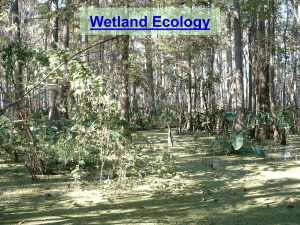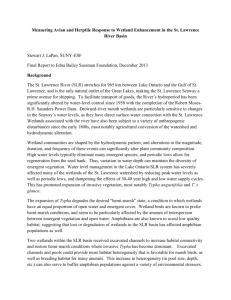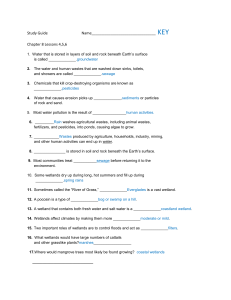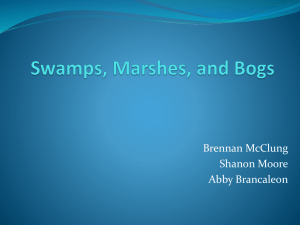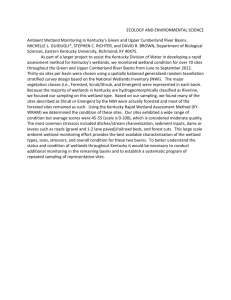Mid Atlantic Coastal Wetlands Assessment Workshop
advertisement
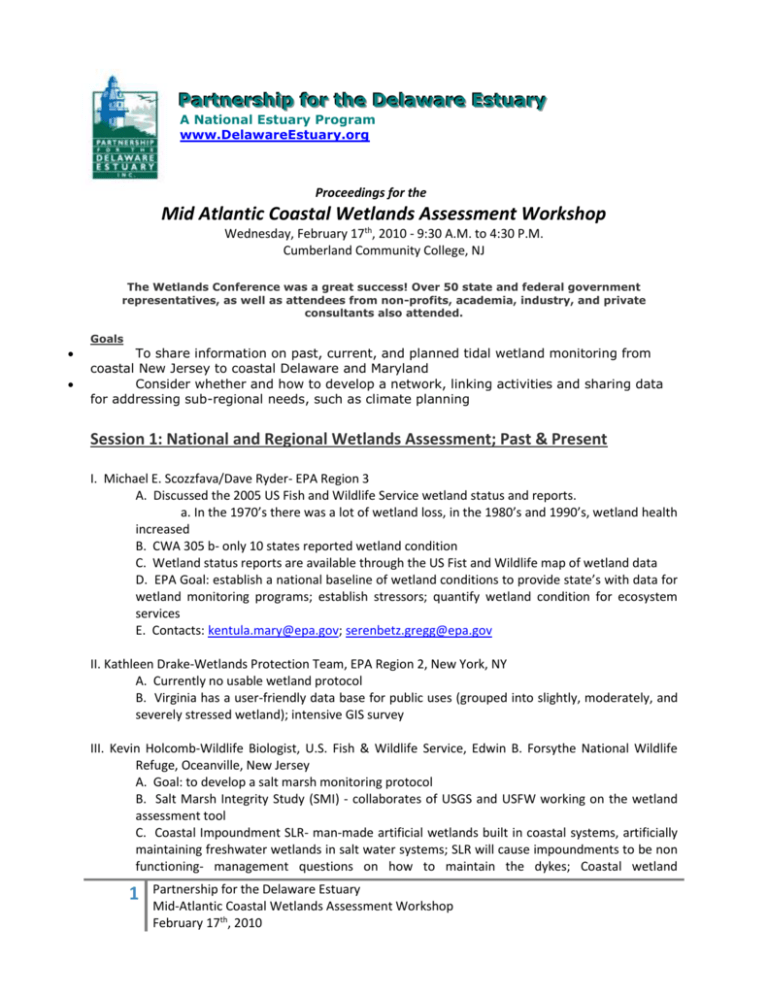
P Pa arrttn ne errssh hiip p ffo orr tth he eD De ella aw wa arre eE Essttu ua arry y A National Estuary Program www.DelawareEstuary.org Proceedings for the Mid Atlantic Coastal Wetlands Assessment Workshop Wednesday, February 17th, 2010 - 9:30 A.M. to 4:30 P.M. Cumberland Community College, NJ The Wetlands Conference was a great success! Over 50 state and federal government representatives, as well as attendees from non-profits, academia, industry, and private consultants also attended. Goals To share information on past, current, and planned tidal wetland monitoring from coastal New Jersey to coastal Delaware and Maryland Consider whether and how to develop a network, linking activities and sharing data for addressing sub-regional needs, such as climate planning Session 1: National and Regional Wetlands Assessment; Past & Present I. Michael E. Scozzfava/Dave Ryder- EPA Region 3 A. Discussed the 2005 US Fish and Wildlife Service wetland status and reports. a. In the 1970’s there was a lot of wetland loss, in the 1980’s and 1990’s, wetland health increased B. CWA 305 b- only 10 states reported wetland condition C. Wetland status reports are available through the US Fist and Wildlife map of wetland data D. EPA Goal: establish a national baseline of wetland conditions to provide state’s with data for wetland monitoring programs; establish stressors; quantify wetland condition for ecosystem services E. Contacts: kentula.mary@epa.gov; serenbetz.gregg@epa.gov II. Kathleen Drake-Wetlands Protection Team, EPA Region 2, New York, NY A. Currently no usable wetland protocol B. Virginia has a user-friendly data base for public uses (grouped into slightly, moderately, and severely stressed wetland); intensive GIS survey III. Kevin Holcomb-Wildlife Biologist, U.S. Fish & Wildlife Service, Edwin B. Forsythe National Wildlife Refuge, Oceanville, New Jersey A. Goal: to develop a salt marsh monitoring protocol B. Salt Marsh Integrity Study (SMI) - collaborates of USGS and USFW working on the wetland assessment tool C. Coastal Impoundment SLR- man-made artificial wetlands built in coastal systems, artificially maintaining freshwater wetlands in salt water systems; SLR will cause impoundments to be non functioning- management questions on how to maintain the dykes; Coastal wetland 1 Partnership for the Delaware Estuary Mid-Atlantic Coastal Wetlands Assessment Workshop February 17th, 2010 impoundments: very important to migratory waterfowls, most national reserve have and maintain impoundments D. Shorebird habitat vulnerability assessment Project- looking at vulnerability aspects of shorebirds through sea level rise. IV. Dorina Frizzera- Environmental Scientist Coastal Management Office, NJ DEP, Trenton, NJ A. C-CAP Land cover mapping of wetlands; www.csc.noaa.gov/crs/lca/class_groups.pew.html B. CICEET- University of New Hampshire- iButtons (dime-sized temperature recording devices: suggested to use, ~15 dollars each) C. Linking wetlands to climate information: NOAA developed a climate portal that will LINK datasets submitted by coastal states (www.climate.gov); interactive dashboard V. Bartholomew Wilson- P.G., Environmental Scientist IV, Delaware Coastal Program, Division of Soil and Water Conservation/ DNREC A. 4 SETS at St. Jone’s Watershed (DNERR) & Blackbird Creek; Blackbird (august/dec 2004- Present) delons (furthest downstream/variable) map shows deep elevation, shallow elevation, accretion deep subsidence and shallow subsidence, beaver branch (on a tributary with lots of development up river) sediment increase due to development, eagles nest (up from delon’s) seasonal changes in accretion due to root biomass increase/ development upstream, blackbird landing B. Take home message- must look at above and below ground biomass C. ways to measure sustenance: marsh vulnerability: correlate spartina growth rate with elevation and growth range.. if spartina is in the middle of its growth rate and the set is saying accretion is lowering; management can become more prepared within a time scale to determine bmps and wetland protection VI. Alison Rogerson-Delaware Department of Natural Resources and Environmental Control, Watershed Assessment Section, Dover, DE A. Two intensive sampling techniques: birds and biomass; bird species richness did not find a relationship between MidTram scores; biomass sampling technique did validate midtrapminimally stressed= increased species richness B. Sampled 22 biomass sites (above and below ground) between 3 watersheds; Below ground biomass- 30 cm core dividing live and dead roots ( is that necessary, the state is exploring it) 3 sites per assessment area, technique: rinse, dry, weight; if live and dead root separation is not necessary then below ground biomass would not be difficult to measure C. All wetland types should have equal score and should react the same, but the fringing wetlands are more impact by human activity therefore they do have a different wetland score (comment from Bart Wilson) Session 2: States, Academia and National Estuary Programs VI. Kathleen Waltz-Ecologist, NJ Natural Heritage Program, NJDEP Division of Parks and Forestry, Office of Natural Lands Management, Trenton, NJ A. Sea level fen is an acidic, groundwater seepage wetland that occurs at sea level in a coastal setting between uplands or freshwater swamps and high salt marsh; infrequently influenced by salt or brackish over wash during unusually high tides 2 Partnership for the Delaware Estuary Mid-Atlantic Coastal Wetlands Assessment Workshop February 17th, 2010 B. Developing a wetland condition monitoring network for New Jersey to try out new assessment methods including NatureServe’s Ecological Integrity Assessment including tier 2 and tier 3; mapping springs; augment the existing floristic quality assessment C. Concerns for OWMW on sea level fens, current project “sea level fen- omwm impact study” funded by cmp and noaa 2006 D. Developing a wetland condition monitoring network for New Jersey to troy out new assessment methods including NatureServe’s Ecological Integrity Assessment including tier 2 and tier 3; mapping springs; augment the existing floristic quality assessment E. Tier 2- plaustrine and estuarine wetland sites using LULC 2007, phys properties, HGM, NVC classes F. Tier 3: 60 wetland monitoring sites using ecological Integrity Assessment; goals of tier 3: establish long-term hydrological monitoring, freshwater algae study, sediment carbon sequestration study, riparian overbank flow study VII. Dorina Frizzera- Environmental Scientist Coastal Management Office, NJ DEP, Trenton, NJ A. New jersey CZM: characterize the vulnerability of the DE Bay coastal landscape inundation, erosion and future sea-level change B. Characterizing vulnerability: geographic, infrastructure, social, environmental and total vulnerability; Geographic vulnerability: soil runoff, flood frequency, soil drainage, soil elevation (lidar), storm surge (slosh model); developed a map of geographic vulnerability C. Project Marco (look at regional infrastructure vulnerability)—maps all firehouses, police stations and hospitals in regions (layered on top of geographic vulnerability) D. Hurricane slosh model- how risk varies in the DE bay VIII. Tom Belton- Research Scientist, NJDEP - Science and Research, Trenton, New Jersey A. Barnegat Bay Coring Project B. Patrick center for the environment- studies using algal diatoms, cores to determine below water anthropogenic concentrations C. Marsh cores- can get data back to 1900 D. Sampling program: two core locals in upper and two core locals in lower; Sampling in mid spring 09; chemical and biological analyses IX. Kevin Hess- Coastal Resource Specialist, Department of Environmental Protection, Harrisburg, PA A. Wetland monitoring assessment program- Pennsylvania B. On going: ambient condition monitoring, mitigation assessment (final stages), HGM classification adoption, functional approach to compensatory requirements, regulatory revisions (on hold) C. Freshwater tidal management- 3 tiered approach; HGM Function Model Based in 90s; draft monitoring strategy, completed pilot study D. 300-400 PA reference wetlands- monitor every 10 years E. Overall strategy: 5 year rotating basing approach F. Based on Land Cover Category: Natural Cover (forest, water), Non-Forest Cover A, Non-Forest Cover B, Effectively Disturbed Cover (all in relationship to streams) G. Results of pilot study: 45 % of PA wetlands in the low condition category 3 Partnership for the Delaware Estuary Mid-Atlantic Coastal Wetlands Assessment Workshop February 17th, 2010 H. Success in landowner permissibility; Concerns of protocol: mostly in level 1 (land cover in 1 km radium, spatial influence); Stressors: invasive species represent 72 % of the stressors (most dominant) at level 1, ~90% of sites sampled had invasive species present I. Present PA intent: use for regulatory classification, prevent TMDL development for individual wetlands, develop TALUs for land cover domains, prioritization of restoration projects J. Condition and function: fine line in regulatory context; warns that some regulatory officials may argue that poor functioned wetlands should be abandoned X. David Velinsky- Senior Scientist and Vice President, Patrick Center for Environmental Research The Academy of Natural Science, Philadelphia, PA A. Current projects at Academy: Rates of Sediment accumulation and marsh accretion in tidal wetland of the DE river Estuary (velinsky, dr. sommerfield) B. New project: habitat changes and nitrogen removal in a tidal freshwater marsh; relating what is “coming in” and what is “coming out” in marsh at Tinnicum, also add a climate change model (slamm possibly) C. Food Web Study- is there a difference between Marsh and Creek- what is the cause of the nitrogen abundance; hypothesized as nitrogen flows from Darby, it is been filtered in the marsh, causing an enrichment between marsh and creek; additional hypothesis- other sources of nitrogen D. Denitrification in Tinicum Marsh: measure of fluxes and rates of denitrification Total Cores: 18, Total Water Blanks:3, Total Bypass Lines: 3 E. “sea-level rise, salt-water intrusion and vertical accretion in total freshwater and salt-water marshes of the de river estuary” Authors: Nathanial Weston, David Vellinsky; three directions for research: plant transplant experiments, microbial processes, sediment inputs; Plant transplants from rancocas: success in salem, raccoon (because of low salinity, stow creek transplant (unsuccessful- too salty); shift in plants from freshwater to marine ecosystems (increase in spartina and wild rice) F. Simulated salt water intrusion in lab: measured CO2 flux; results is a tremendous increase in co2 when freshwater cores were exposed to a salt water intrusion; Methane flux- uncertain on why methane levels still high because there should have been a decrease G. Projects of 2010: marsh “organ” experiments, SET, sediment delivery (Beryllium &) DE Estuary: Crosswick creek, tinicum marsh, Christina river, st. jone’s river, and stow creek (villanova creek); Maurice and Dennis Creek (Rutgers) XI. Kurt Philipp-President, Wetlands Research Services, Newark, DE A. Tidal Wetland Monitoring Studies in the Delaware Estuary B. STAC Project- looking at all historical maps in DE Estuary and almost all of the estuary has had physical changes (dyking, ditching) C. Tidal Creeks help explain the history of the marsh D. Blackbird creek: scrub shrub ecotone was moving landward ( from 1930 to present); Net conversion of high marsh to low marsh (32% loss) E. Marsh change maps; Weatherbee, 2002 from UDel F. Cohansey River Watershed Site- Phragmites management site (PSEG estuary enhancement program); Restoration of salt hay meadows ( farm high marsh spartina paytons); part of estuary enhancement program; Sediment and accretion data were collected on the estuary enhancement sites (cohansey, Maurice, dennis, alloway); Marsh restoration trajectories graph 4 Partnership for the Delaware Estuary Mid-Atlantic Coastal Wetlands Assessment Workshop February 17th, 2010 G. Data inventory: PSEG monitoring data- available; annual report; sediment data NOT in annual report, but is available upon request; annual report contains fish and biomass XII. Christopher Bason- Science & Technical Coordinator, Delaware Center for the Inland Bays, Rehoboth Beach, DE A. Level one assessment- historical aerial photo analysis- 1930’s- examine historical photos (loss of acreages, conditions, etc) B. El Niño southern oscillations, tidal symmetry, exploring condition using vegetation index (developed by Dr. Field) C. Addition of pH meters into the field XIII. Martha Maxwell-Doyle-Project Coordinator, Barnegat Bay National Estuary Program, Toms River, NJ XIV. Danielle Kreeger- Science Director, Partnership for the Delaware Estuary, Wilmington DE Session 3: Panels on rapid assessment and fix monitoring stations Question: Why monitoring and assess tidal wetlands? Responses: the major response was water quality Secondary and Tertiary Responses: healthy wildlife, land acquisition, school outreach, flood protection; recreation (tom belton gives example that people took an interest in algal blooms in Barnegat when they realized their children could no longer swim in the estuary) Thoughts: Need to tell a story and make preservation personal; assist municipalities in wetlands conservations; need to relate preservation and conservation to financial gains (shellfish industry, etc); Other remarks: DELA (Delaware Estuary Levee Assocation)- repair dykes and levees Question: What we know and do not know? Responses: need more wildlife studies including fish wildlife; economics (direct monetary values for wetland preservation); evaluate salinity lines; climate change effects Secondary and Tertiary responses: citizen monitoring programs and volunteer monitoring (Chris bason has a successful program in the CIB) 5 Partnership for the Delaware Estuary Mid-Atlantic Coastal Wetlands Assessment Workshop February 17th, 2010

